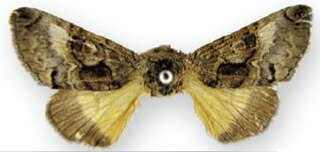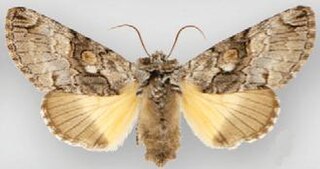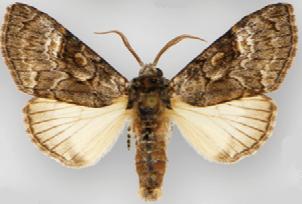
The Noctuidae, commonly known as owlet moths, cutworms or armyworms, are a family of moths. They are considered the most controversial family in the superfamily Noctuoidea because many of the clades are constantly changing, along with the other families of the Noctuoidea. It was considered the largest family in Lepidoptera for a long time, but after regrouping Lymantriinae, Catocalinae and Calpinae within the family Erebidae, the latter holds this title now. Currently, Noctuidae is the second largest family in Noctuoidea, with about 1,089 genera and 11,772 species. However, this classification is still contingent, as more changes continue to appear between Noctuidae and Erebidae.

Pantheinae is a small subfamily of moth family Noctuidae. It used to be considered a family, under the name Pantheidae.
Craugastor charadra is a species of frogs in the family Craugastoridae.

Charadra is a genus of moths of the family Noctuidae.

Charadra deridens is a moth of the family Noctuidae. It is found in Ontario, Quebec, New Brunswick, Nova Scotia, Prince Edward Island, British Columbia, Saskatchewan and Manitoba in Canada, through most of the United States except the south-western states.

Raphia frater, the brother moth or simply the brother, is a moth of the family Noctuidae. It is found from Nova Scotia west, across the forested regions of Canada to British Columbia, south to Mississippi in the east. The southern limits in the west are uncertain due to confusion with several closely related species or forms.

Aseptis ethnica is a moth of the family Noctuidae first described by John Bernhardt Smith in 1899. It is found in North America in Arizona, California, western Oregon, and Baja California Norte in Mexico. The habitat consists of open pine and oak forest and mountain chaparral, mostly at elevations of above 1500 meters in southern California but at lower elevations farther north.

Charadra pata is a moth of the family Noctuidae. It is known only from Guatemala City in Guatemala.

Charadra patafex is a moth of the family Noctuidae. It is known only from Guerrero Mill in the State of Hidalgo in Mexico, where it was found at 9000 feet elevation.

Charadra franclemonti is a moth of the family Noctuidae. It is found from central Arizona southward to at least Durango in Mexico.

Charadra tapa is a moth of the family Noctuidae. It is found in the Chiricahua, Huachuca, and Santa Rita Mountains of south-eastern Arizona, although the species probably occurs in adjacent parts of Mexico.

Charadra cakulha is a moth of the family Noctuidae. It is known only from two specimens of the type series, collected in mid-June at San Cristobal de las Casas, Chiapas, Mexico.

Charadra coyopa is a moth of the family Noctuidae. It is known only from the holotype specimen from the Mexico City area.

Charadra moneta is a moth of the family Noctuidae. It is found from central and eastern Arizona, the San Mateo Mountains of New Mexico, the Guadalupe Mountains of New Mexico and Texas, and the Big Bend region of Texas; south to the Sierra Madre in Nuevo León, northern Mexico.

Charadra dispulsa is a moth of the family Noctuidae. Its range spans from Texas southward and westward to at least San Luis Potosí, Mexico.

The Erebidae are a family of moths in the superfamily Noctuoidea. The family is among the largest families of moths by species count and contains a wide variety of well-known macromoth groups. The family includes the underwings (Catocala); litter moths (Herminiinae); tiger, lichen, and wasp moths (Arctiinae); tussock moths (Lymantriinae), including the arctic woolly bear moth ; piercing moths ; micronoctuoid moths (Micronoctuini); snout moths (Hypeninae); and zales, though many of these common names can also refer to moths outside the Erebidae. Some of the erebid moths are called owlets.
Acentrella charadra is a species of small minnow mayfly in the family Baetidae.
Charadra was a city of ancient Phocis, and one of the Phocian towns destroyed by Xerxes I in 480 BCE during the Greco-Persian Wars. Pausanias describes Charadra as situated 20 stadia from Lilaea, upon a lofty and precipitous rock. He further states that the inhabitants suffered from a scarcity of water, which they obtained from the torrent Charadrus, a tributary of the Cephissus, distant three stadia from the town. Situated in the agora of the town, Pausanias noted altars of heroes; some thought they were of the Dioscuri, others thought they were of local heroes.
This page is based on this
Wikipedia article Text is available under the
CC BY-SA 4.0 license; additional terms may apply.
Images, videos and audio are available under their respective licenses.












